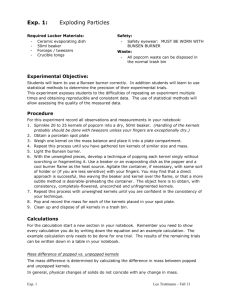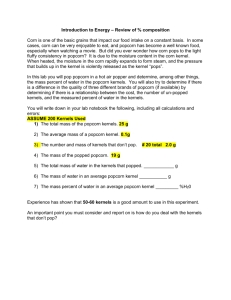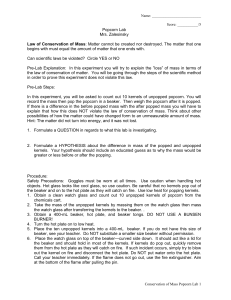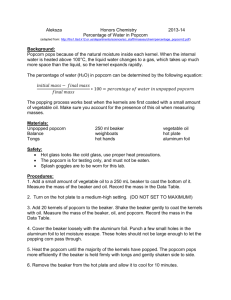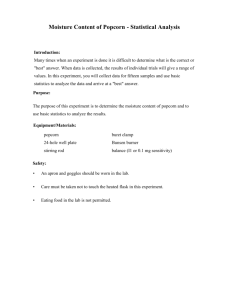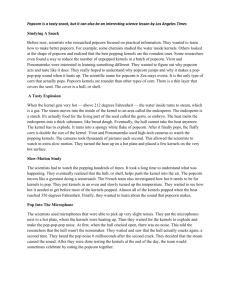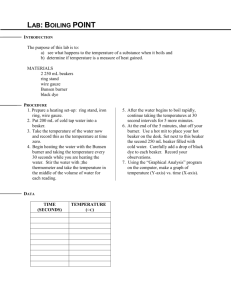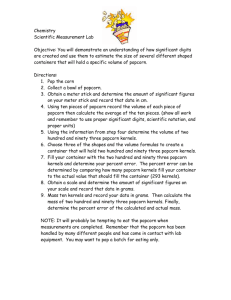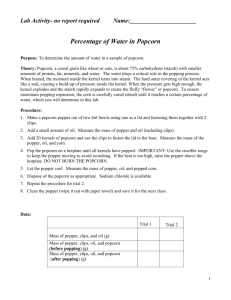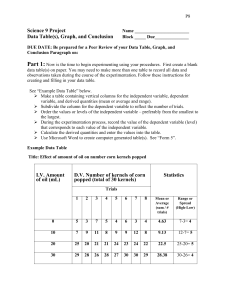mass lab
advertisement
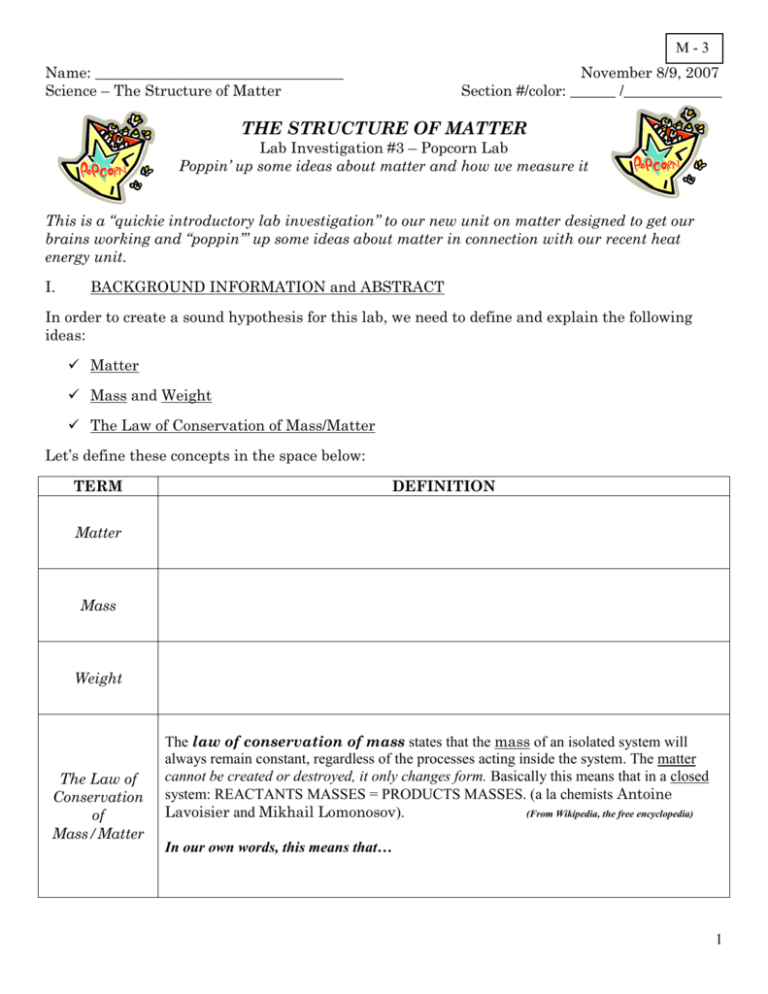
M-3 Name: _________________________________ Science – The Structure of Matter November 8/9, 2007 Section #/color: ______ /_____________ THE STRUCTURE OF MATTER Lab Investigation #3 – Popcorn Lab Poppin’ up some ideas about matter and how we measure it This is a “quickie introductory lab investigation” to our new unit on matter designed to get our brains working and “poppin’” up some ideas about matter in connection with our recent heat energy unit. I. BACKGROUND INFORMATION and ABSTRACT In order to create a sound hypothesis for this lab, we need to define and explain the following ideas: Matter Mass and Weight The Law of Conservation of Mass/Matter Let’s define these concepts in the space below: TERM DEFINITION Matter Mass Weight The Law of Conservation of Mass/Matter The law of conservation of mass states that the mass of an isolated system will always remain constant, regardless of the processes acting inside the system. The matter cannot be created or destroyed, it only changes form. Basically this means that in a closed system: REACTANTS MASSES = PRODUCTS MASSES. (a la chemists Antoine Lavoisier and Mikhail Lomonosov). (From Wikipedia, the free encyclopedia) In our own words, this means that… 1 In this lab we will focus on proving the Law of Conservation of Mass/Matter to be correct. We will use our measuring skills to identify the mass of popcorn before and after it is popped. We will compare these measurements and use them as evidence to support or refute the aforementioned law. Because this lab is about the matter of popcorn and popping it, you will need to know a little about WHAT makes it pop. Below is some information for you to ponder: POPCORN… What makes it pop? Popcorn pops because of its 13.5% water content, its starchy interior, and its non-porous shell. also heat up. gas. When we heat up the kernels the water molecules This causes them to move faster, expand and change into a The pressure inside the shell is so great that it causes the water vapor to condense again and combine with the starch of the kernel to make a jelly-like mixture. As we continue to add heat to the kernel, the pressure eventually becomes too great for the shell to contain the expanded and heated water and starch jelly-like mixture. The kernel then pops, releasing the pressurized liquid water and starch. The starch rearranges itself molecularly into the white crunchy poof you eat; the water, because it is now depressurized but still quite hot, is turned into water vapor. II. PROBLEM Mrs. P would like you to do a lab investigation that proves whether or not the Law of Conservation of Mass/Matter holds true in the matter of popping popcorn. Using the terms from the background information and abstract of the lab, let’s define the problem and state the reason why it’s important to experiment with it… __________________________________________________________________________________________ __________________________________________________________________________________________ __________________________________________________________________________________________ __________________________________________________________________________________________ 2 III. HYPOTHESIS Now, let’s make a tentative, testable, and tied to guess about the matter of this problem. Remember to look back to the background information and abstract when doing this (as well as your own prior knowledge!). __________________________________________________________________________________________ __________________________________________________________________________________________ __________________________________________________________________________________________ __________________________________________________________________________________________ IV. PROCEDURE Let’s use some popcorn to see if this whole “matter” of mass being “conserved” is true! MATERIALS: 2 Beakers Hot hands or Thongs 20 kernels corn Ring stand Bunsen burner Funky eye wear Wire gauze Bunsen burner lighter Triple beam balance 1) Get a partner. 2) Put on safety goggles. 3) Place 10 popcorn kernels each in two beakers. 4) Cover the top of the beakers with foil. Make sure you still can see the kernels. 5) Mass each of the beakers and record the masses to the nearest 100th of a gram. 6) Repeat step 5 two more times for each beaker. 7) Find the average mass of each beaker. 8) Place one of the beakers on the ring stand. Place the other to the side. 9) Turn on the gas and light the Bunsen burner. 10) Heat the kernels until they pop. Do this by slowly “swirling” the Bunsen burner flame under the bottom of the beaker. USE THE HOT HANDS! 11) Observe the kernels CLOSELY as you are heating them; also observe the kernels in the control beaker. 12) Write down any observations in the data section of your lab. 13) DO NOT HOLD THE FLAME TOO CLOSE TO THE BEAKER OR YOUR KERNELS WILL NOT BECOME POPCORN BUT MINIATURE CHARCOAL BRIQUETTES INSTEAD (i.e. petrified and blackened corn kernels). 3 14) Be very patient…be in the moment and enjoy the heating process! You will be rewarded with well-popped kernels! 15) Do NOT get stubborn with any stubborn kernels (i.e. do not try to get the kernels that just won’t pop to pop and end up burning your popped kernels!). 16) Turn off the gas and the Bunsen burner. 17) With the hot hands CAREFULLY move the beaker to the balance. 18) Mass the popped corn without removing the foil or the corn from the beaker. Record the mass to the nearest 100th of a gram. Repeat this for the un-popped corn. 19) Repeat step 18 two more times. 20) Find the average mass for each beaker. 21) Compare your post-popping and pre-popping masses. Find the differences and record it to the nearest 100th of a gram. 22) Give your results to Mrs. P so she can obtain a class average of data. 23) Do not eat your "scientifically Bunsen burner assisted” popped corn. Instead, please throw out the scientifically-experimented-upon popcorn and wash out your beakers. Return the beakers to where you found them. 24) Make a hand-drawn or excel graph of your data. 25) Write up the REST of the lab using the directions that follow as well as the scientific process outline you have in one of your science folder sheet protectors. Also, don’t hesitate to refer to all the steps you took in writing up the can lab! 4 V. DATA AND OBSERVATIONS BEAKER Control Experimental Mass 1 Mass 2 Mass 3 Average Beaker Data YOUR DATA AVERAGE PRE-POPPING MASS (g) AVERAGE POST-POPPING MASS (g) DIFFERNCE IN MASS (g) Control Experimental CLASS AVERAGE Control Experimental 5 OBSERVATIONS: _____________________________________________________________________________________ _____________________________________________________________________________________ _____________________________________________________________________________________ _____________________________________________________________________________________ _____________________________________________________________________________________ _____________________________________________________________________________________ _____________________________________________________________________________________ _____________________________________________________________________________________ _____________________________________________________________________________________ _____________________________________________________________________________________ ______________________________________________________________________________________ _____________________________________________________________________________________ _____________________________________________________________________________________ ______________________________________________________________________________________ ______________________________________________________________________________________ 6 YOUR AT-HOME ASSIGNMENT: Now, type or write up by hand (on a separate sheet of paper) the remaining parts of the lab. Don’t forget to refer to your scientific process outline and the directions below when doing this. Keep in mind that your final lab report must include the following: A neat and complete lab packet. A typed or hand written discussion, conclusion, and reformulation. At least one hand-drawn and/or excel graph of the difference in mass data for the class and your own experiment. ON VI. DISCUSSION Write an analysis of what you observed during and after your eye-popping experience with popping matter. Include in your reflection the following: 1) A description of what visually happened to the kernels in the control and experimental group throughout your experiment. 2) An evidence sandwich (THE ANSWER, THE EVIDENCE, THE CONNECTION) that answers the questions of this lab. To support your answer, be sure to: Refer to the data table of averages and the graph for both your own and the class’s results. Make comparisons between the control and experimental groups. Explain or account for any variables (i.e. error) in your procedure and how it could have affected your results in trying to prove or disprove The “Law of Conservation of Matter (mass).” VII. CONCLUSION Summarize your findings and tell whether or not your hypothesis was correct…did we prove the law of conservation of mass with the matter of popping corn to be true? Why or why not? What was the effect of changing the appearance of matter on the mass of the matter? VIII. REFORMULATION What new question about matter, mass, and/or the law of conservation of mass do you have? Come up with a new question to wrap up this “eye-popping”, “matter-of-fact” situation (make sure it is the “What effect does x have on y?” form! Include a reason why you want to research this new question. Your final lab report is due on FRIDAY, NOVEMBER 11th ! 7 NOTES FOR WRITE-UP: 8
